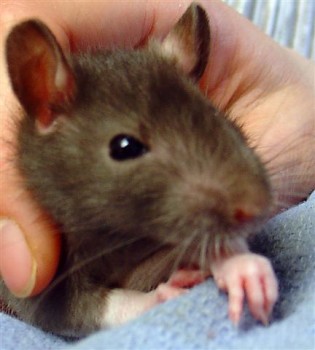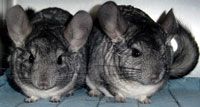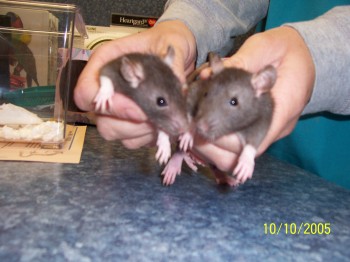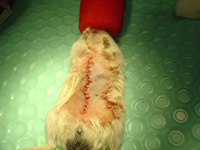|
Rodent Veterinary Care in Gilbert AZ @ Little Critters Vet
By: Jill M. Patt, DVM
Rats, Guinea Pigs, Chinchillas, Mice, Hamsters, Gerbils
|

|
RODENT INFORMATION
INTRODUCTION:
We commonly see a variety of rodents in practice and like all exotic species, many of their health problems are due to inappropriate feeding or husbandry. Much of the information provided will be specific information on caring for these animals as well as links for further information. Also included will be a discussion of the common medical problems we see in each species. Further pictures and case information will be available at my gallery.
|
|

|
Various Rodents:
Guinea Pigs
Pet Quality: Excellent
Guinea Pigs can make excellent pets for both adults and children. They are affectionate and gentle animals and will bond well with their owners when handled often. They can be housed in pairs or small groups but I do recommend neutering the males. The average lifespan is around 4 years of age, but exceptions do occur. Like all exotics there are special concerns that should be addressed such as:
Vitamin C
Guinea Pigs are unable to make their own vitamin C and therefore must have a vitamin C supplement provided daily. If adequate vitamin C is not provided, the pigs will develop vitamin C deficiency, also called scurvy, leading to a suppressed immune system. Affected pigs are much more susceptible to disease and respiratory infections are very commonly the first sign of immunosuppression, with arthritis, tooth disease and many others also frequently seen. Early signs of respiratory infection include tearing and crusting around eyes, sneezing, weight loss and nasal discharge. I recommend providing chewable vitamin C tablets or powdered vitamin daily to all guinea pigs throughout their lives. I recommend giving a minimum of 50mg vitamin C daily and this dose should be increased for pregnant guinea pigs and those with deficiency to at least 200mg daily. Additionally, all guinea pigs should be provided with at least 1/2 cup of fresh dark leafy greens daily for a natural source of vitamins and nutrients. Many leafy greens are available and will vary with the seasons, but a couple of good ones are kale and parsley.
|
|

|
Other dietary recommendations:
Guinea pigs should be fed a grass hay based pellet and provided grass hay daily in addition to their greens. Guinea pigs do love to eat but treats high in sugar or grain should be limited to keep their GI tract healthy. Because of their rotund body shape, pigs are susceptible to foot sores when housed on wire bottom cages. The new plastic bottom cages are a better choice to keep your pig comfortable. Avoid all wood chip bedding, what can cause allergies and other respiratory problems, recycled paper bedding is usually a safer alternative. A hide box should also always be provided to allow a stressed pig to escape. Toys should be provided, including safe chewable wood toys made for guinea pigs. A water bottle and food bowl will also be required.
Dental Disease:
All of their teeth (incisors & molars) will continue to grow throughout the animals life. All guinea pigs should be examined yearly by a veterinarian and part of their physical exam should include an oral examination. With malocclusion, the molar teeth can grow longer on the inside surface and cause pain when eating. With progression of the disease the teeth can actually form an arch that entraps the tongue and prevents the pig from eating. Signs of dental disease are often limited to weight loss or anorexia, but may also include dropping food when chewing or salivation. The front teeth or incisors can also become over grown and may require trimming by your veterinarian. The incisors should never be clipped with nail trimmers because this can actually result in a break higher up in the tooth. Your veterinarian will use a dental bit or dremel to quickly and safely reduce the tooth length. Molar teeth can be more difficult to trim because of the small oral cavity and will usually require general anesthesia to allow access to the back of themouth.
|
|

|
Skin Disease:
Signs of skin disease include, scratching, hair loss with bald spots, skin flaking and skin wounds. Some guinea pigs will be so itchy that they will have what appears to be a seizure to the owners. Skin disease can occur when stressed from new surroundings or due to vitamin C deficiency or both. It is not uncommon for guinea pigs to develop mite infestations, lice (not the human type), and ringworm. The best course of action is to have all itchy pigs examined by a veterinarian. Skin scraping and fungal culture may be needed for a diagnosis. Treatment for ringworm (which is infectious to humans) involves the application of topical antifungal medication. Treatment for mites may vary with the veterinarian. In the past an injection of ivermectin (an anti-parasitic medication) was most often used. Today, many veterinarians use the topical skin product called Revolution. The product is just applied to the skin between the shoulders and will protect the animal’s entire body for up to a month. The product is not approved for exotic animals but is commonly used very safely under the direction of a veterinarian. Your vet will determine the correct dose
|
|

|
Surgery?
At this time, do not recommend spaying female guinea pigs because it is, in my opinion, a high risk procedure. However, males housed with females should be neutered because female guinea pigs who have not been pregnant prior to roughly 6mo-1yr of age will fuse their pelvis. As a result, later pregnancies are at a higher risk of dystocia or stuck/retained babies. Neutering guinea pigs is a relatively quick and safe procedure with few complications. The most common complication seen is the development of an abscess or infection at the site of the neuter. We attempt to minimize this by performing a sterile surgery and leaving an area for drainage at the scrotum. Owners can also help to minimize the risk by housing the guinea pig alone while recovering and changing the bedding twice daily to keep the environment very clean. If an abscess does occur it is lanced and drained/debrided and the pet is placed on antibiotics.
|
|

|
Chinchillas:
Chinchillas are South American rodents that can make excellent pets. They are long lived, with an average of a 15+ year lifespan. I often recommend chinchillas for those people considering purchasing an exotic pet. They are typically very gentle and become very tame when handled on a regular basis. Chinchillas come in a variety of beautiful colors, have a soft luxurious coat, are relatively quiet and, unlike small mammals such as ferrets, they have no real body odor. When well cared for they are healthy and unlike the other more common pet rodents, chinchillas are likely to be around much longer as they typically have a long life span.
Diet:
Chinchillas have a sensitive gastrointestinal tract and should be given a routine diet that doesn’t vary on a daily basis. I recommend feeding them a mixture of chinchilla pellets, grass hay and some alfalfa hay for additional calcium.
Supplementation?
We know that guinea pigs are unable to make their own internal (intrinsic) vitamin C and will get scurvy without daily supplementation. However, it remains undetermined as to weather or not chinchillas can make their own vitamin C. The safest course of action is to supplement their diet with a chewable (XtraC from oxbow is a good choice) vitamin C tablet of about 100-200mg/day. A calcium supplement may also be needed if the diet is low in calcium or for pregnancy.
|
|

|
Housing
A flat bottom cage is safest for their toes and feet but will require much more diligent cleaning. Wood shaving are not recommended for rodents and the best choice for bedding is hay or recycled newspaper pellets. The cage should be the largest that you have room for and the use of a multiple level cage will increase their area of activity. Chinchillas are very active animals and are most active at night. They should be provided with monitored time out of the cage daily to allow them to run and play. A chinchilla wheel should always be available in the cage. A typical rabbit water bottle and food bowl should also be provided. Also, a hide box should be provided to allow them a feeling of security and a means of escaping if startled or stressed.
Dusting
All chinchillas should be allowed access to a dust bath on a regular basis. Special chinchilla dust can be purchased at most pet shops and should be provided daily in a container. Common containers are litter boxes (covered work well) and large mouthed class jars big enough for the chinchillas to freely move around in. The container should be removed after the bath. Chinchillas have a very thick coat that does not dry quickly when wet. Dusting is their way of having a water free bath. Dusting allows them to remove oil and debris from their coats and truly seems to be a source of enjoyment.
Chewing
Like other rodent teeth, chinchilla teeth continue to grow throughout their lives. Normal healthy chinchillas should have yellow incisors. White incisors are often a non-specific sign of illness. All chinchillas must be given appropriate items to chew on throughout the day. Hay provides a good source of nutrition as well as fiber for chewing. They should also be provided with wood chew toys and pumice stones made for chinchillas. Always monitor chinchillas when allowed play time out of the cage because they will chew on just about anything.
Selected Problems
- Heat: Chinchillas are from high mountainous areas and are well outfitted for cold weather. As a result of their thick coat chinchillas over heat quickly and should always be housed indoors with an air conditioner. If overheated they should be quickly transported to a veterinarian.
- Eyes: They can suffer eye infections and irritations from dust and debris. Any chinchilla with tearing, redness, or squinting should be examined by a veterinarian.
- Teeth: Like guinea pigs, chinchillas can suffer from many dental problems such as overgrown molars and abscessed teeth. Common signs of dental disease are wet chin fur, weight loss, dropping food and avoiding hard foods. Part of a chinchilla’s annual veterinary exam is a through dental exam.
- Fur: If grabbed suddenly or inappropriately the fur will literally come off in clumps leaving patches of alopecia. Always handle a chinchilla gently and never grab the fur. Ringworm and mites can also result in hair loss and itchy skin. During the annual examination your veterinarian will ensure that your chinchilla has a healthy coat and skin.
- Grooming: Chinchillas will shed and ingest hair when grooming. They should be groomed on a regular basis to remove loose hairs. Intact males used for breeding can develop hair rings around the penile area that can cause constrictions and they should be carefully checked for these.
- Aggression with cage mates: As I’ve said, chinchillas are commonly very gentle animals but sometimes will become aggressive bullies when the same sexes are housed together. It is best to have only a single chinchilla or a male and female.
- Respiratory: Chinchillas can develop pneumonia from a variety of bacterial pathogens and any chinchilla showing increased respiratory effort, nasal discharge and/or weight loss should be examined by a veterinarian.
- Surgery: I don’t recommend spaying female chinchillas, but male chinchillas housed with females should be neutered to prevent disease and pregnancies. For more information on neutering see the ChinCare page which is linked below.
|
|

|
MICE, RATS, HAMSTERS, GERBILS
Rodents are true pocket pets that do not take up much room and are easy and inexpensive to acquire and care for. In my opinion, out of all the various small rodents, rats tend to make the best pets. They will become very tame and friendly and will interact with the family. Hamsters are popular pets, are cute and fuzzy, but do have more of a tendency to bite then some of the other rodents. Mice also make good pets but tend to be a little more active and then rats. Gerbils generally are very tame and sweet and typically are not bitters, but again are very active and must be socialized well to be a good pet. The primary drawback with all our small rodents species is their limited life span, with a 2yr old often considered an old rodent.
|
|

|
RATS:
As with all pets, many health problems can potentially develop. However, a couple of the more common problems in rats are upper respiratory infections and mammary gland tumors. Respiratory infections are contagious among rats and the ill pet will often exhibit tearing (often red tears), nasal discharge and sneezing. If caught early the infection can be treated by your veterinarian. Mammary gland tissue is present over a wide area on rats and tumors are very common anywhere on the body. Often these tumors are benign but will still cause the rat problems due to the large size. Tumors can be surgically removed by your veterinarian. Always choose any new pet carefully. As with all animals, it is better to acquire your new pet from a reputable small breeder rather then a chain store which mass produces rats. Rats from pet shops or mass breeders tend to have more health problems because various sources are often mixed together and the breeding is indiscriminate. It is best to go to a small local breeder who is breeding selectively and socializing the rats early in life. It is always best to choose your new pet rat as carefully as you would a new puppy.
|
|
|


|
HAMSTERS:
Hamsters are likely the most popular of the small rodents and are available in a variety of sizes, coat colors and lengths. Hamsters do have a reputation for biting, especially when awoken. Always buy young hamsters that have been handled and socialized well. Common problems we see with hamsters are broken limbs (often from wire cages), diarrhea, mites and hormonal disease. All small rodents should be housed on a solid bottom cage because their small feet are easily caught in wire caging and frequently a fracture is the result. Wet tail or diarrhea is a common problem in hamsters and can be fatal if not addressed early. The small hamster will quickly become dehydrated if not treated promptly. Over the counter medications should never be used because they often are dosed inappropriately and may not even treat the actual infection. Your veterinarian will be better able to identify the problem and treat it correctly. Mites are a common problem in all rodents and infected animals will be itchy and have hair loss, skin wounds, and flaky skin. Mites can be treated easily by your veterinarian with a variety of possible treatments. Lastly, older female hamsters can develop a hormonal condition that often looks like a mite infestation. The females will loose hair and are often very itchy. Again, your veterinarian is the best person to diagnose this condition.
MICE:
Mice have many of the same problems as rats and a similar short lifespan. One problem we see in both rats and mice is tail trauma. If picked up by their tails the skin will actually slip off leaving unprotected tissue and bone. Rodents should therefore never be picked up by their tails. Also, in my experience mite infestations seem to be more common in mice and the affected individual will have hair loss, thickened skin and will be very itchy.
|
|

|
|
GERBILS:
Gerbils generally make excellent pets and like hamsters they come in a variety of colors and coat textures. I prefer to house gerbils in same sex pairs, but if not already housed together they may fight. Also, overcrowding of gerbils or rodents in general, will result in a variety of health concerns due to stress, such as increased infections and behavioral problems. Gerbils should be purchased at a young age for a reputable breeder that has socialized them well. Tame gerbils will be anxious to be with you and interact with the family. They tend to be fairly healthy animals, but can acquire the same health concerns as other small rodents. Tail trauma is always a problem and again, rodents should never be picked up by their tails. Gerbils have a bare patch of skin on their abdomen that is actually a scent gland. Occasionally the scent gland will develop a tumor that can be surgically removed. Respiratory and gastrointestinal infections can also occur.
|


|
|
|

|
RODENT GENERALIZATIONS/ SUMMARY
- Long tailed rodents are subject to skin slip and should never be picked up by the tail
- Don’t house rodents on wood shavings which can cause allergies. Instead, use recycled paper pellet
- Healthy rodents have yellow teeth. Many types of rodents have teeth that grow throughout their life and can overgrow resulting in difficulty eating.
- Many rodents have reddish tears and mucus that is often mistaken for blood.
- Never house rodents in cages with wire floors.
- It is best to buy two rodents from the same source at the same time.
- If male and female rodents are kept together the male should be neutered. Neutering of male rodents is a common procedure that will prevent pregnancies and should be available at most exotic veterinarian hospitals.
- Standard rodent chow for your particular species is usually the best food (rats, mice, gerbils)
- All rodents need room to move and exercise and various toys and wheels should be provided.
- Over crowded rodents or those in too small a cage will become stressed and suffer from many health problems.
|
|
|
RODENT MEDICAL CARE
Many of our clients are excellent rodent owners and will bring their pets in for examination at the first sign of trouble. However, occasionally we will have a new client with a sick rodent and the client will express concern at spending additional monies on a pet that cost only a few dollars to purchase. While it is true that rodents are largely inexpensive, they are often just as good a pet as our more common cats and dogs, and they are no less deserving of medical care. It is our responsibility as pet owners to provide our small family members with a good quality of life and this entails not only feeding and housing, but also treating and curing illness. No animal should be made to suffer based on the monetary value of the pet. Ask yourself if you would not treat a ill dog that had been given to you. Your response for this ill dog should be no different then an ill rodent that requires your aid.
LINKS
EMV: Association of Exotic Mammal Veterinarians: http://aemv.org/
Center for Disease Control – healthy pets http://www.cdc.gov/healthypets/ Information on infectious diseases that human can acquire from animals. Includes a owner handout on lymphocytic choriomeningitis virus in rodents.
Guinea Pigs
Guinea Pig lynx: http://guinealynx.info/healthycavy.html
CHINCHILLAS
Chinchilla Page – ChinCare http://www.chincare.com/
MICE, RATS, HAMSTERS, GERBILS
Rats & Mice http://AFRMA.org
Rat Lovers http://RatLovers.org
Hamsters:
http://petwebsite.com/hamsters.asp
Gerbils:
http://www.agsgerbils.org/ – American Gerbil Society – EXCELLENT
|
|